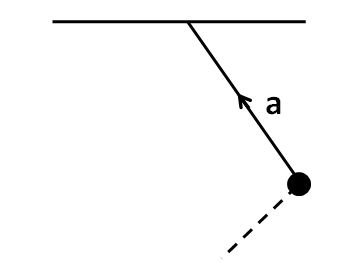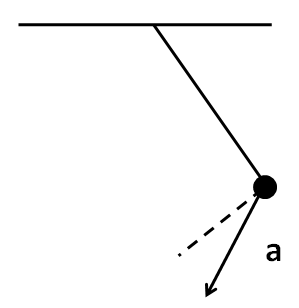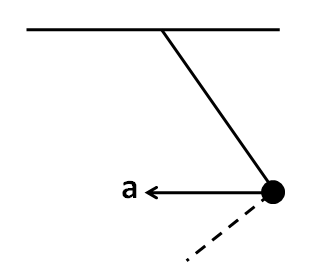Answer
413.4k+ views
Hint: To solve this question, we need to consider the free body diagram of the bob of the given pendulum at a position when its displacement has a less than maximum value. Then the direction of the acceleration vector will be the same as the direction of the net force.
Formula Used: In this solution we will be using the following formula,
$\Rightarrow {F_{net}} = ma $ where $ {F_{net}} $ is the net force acting on a body, $ m $ is the mass and $ a $ is the acceleration of the body.
Complete step by step answer
Let the length of the string of the pendulum be $ L $.
When the displacement of the bob of the pendulum is less than maximum, then the free body diagram of the bob is shown below. Let the velocity of the bob be equal to $ v $ at this instant.
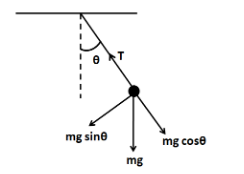
Let the string of the pendulum make an angle of $ {{\theta }} $ with the vertical. The forces acting on the bob are
Weight - $ mg $
Force of tension - $ T $
We have resolved the weight of the bob into radial and tangential directions. Now, we know that the bob of the pendulum undergoes vertical circular motion. So there must be a net centripetal force towards the centre. So from the Newton’s second law we have
$\Rightarrow T - mg\cos {{\theta }} = \dfrac{{m{v^2}}}{L} $
$ \Rightarrow {F_R} = \dfrac{{m{v^2}}}{L} $ …………………………...(1)
Here $ {F_R} $ is the net force in the radial direction.
Also the net force along the tangential direction is $ mg\sin {{\theta }} $. This means that
$\Rightarrow {F_T} = mg\sin {{\theta }} $ ……………………….(2)
So the net force on the bob is given by
$\Rightarrow F = \sqrt {F_R^2 + F_T^2} $
From (1) and (2)
$\Rightarrow F = \sqrt {{{\left( {\dfrac{{m{v^2}}}{L}} \right)}^2} + {{\left( {mg\sin {{\theta }}} \right)}^2}} $ ……………………..(3)
So the net acceleration of the bob is given by
$\Rightarrow a = \dfrac{F}{m} $
From (3)
$\Rightarrow a = \dfrac{1}{m}\sqrt {{{\left( {\dfrac{{m{v^2}}}{L}} \right)}^2} + {{\left( {mg\sin {{\theta }}} \right)}^2}} $
$ \Rightarrow a = \sqrt {{{\left( {\dfrac{{{v^2}}}{L}} \right)}^2} + {{\left( {g\sin {{\theta }}} \right)}^2}} $
The direction of this acceleration will be the same as the direction of the net force. The direction of the net force is shown in the figure below.
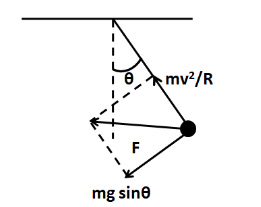
So the direction of the net acceleration is shown as
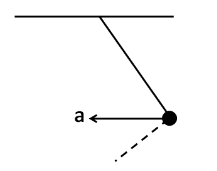
Hence, the correct answer is option C.
Note
In this solution, we have used the parallelogram law to determine the direction of the acceleration of the bob of the pendulum. We can use any one of the laws of vector addition, like the triangular law for this purpose.
Formula Used: In this solution we will be using the following formula,
$\Rightarrow {F_{net}} = ma $ where $ {F_{net}} $ is the net force acting on a body, $ m $ is the mass and $ a $ is the acceleration of the body.
Complete step by step answer
Let the length of the string of the pendulum be $ L $.
When the displacement of the bob of the pendulum is less than maximum, then the free body diagram of the bob is shown below. Let the velocity of the bob be equal to $ v $ at this instant.

Let the string of the pendulum make an angle of $ {{\theta }} $ with the vertical. The forces acting on the bob are
Weight - $ mg $
Force of tension - $ T $
We have resolved the weight of the bob into radial and tangential directions. Now, we know that the bob of the pendulum undergoes vertical circular motion. So there must be a net centripetal force towards the centre. So from the Newton’s second law we have
$\Rightarrow T - mg\cos {{\theta }} = \dfrac{{m{v^2}}}{L} $
$ \Rightarrow {F_R} = \dfrac{{m{v^2}}}{L} $ …………………………...(1)
Here $ {F_R} $ is the net force in the radial direction.
Also the net force along the tangential direction is $ mg\sin {{\theta }} $. This means that
$\Rightarrow {F_T} = mg\sin {{\theta }} $ ……………………….(2)
So the net force on the bob is given by
$\Rightarrow F = \sqrt {F_R^2 + F_T^2} $
From (1) and (2)
$\Rightarrow F = \sqrt {{{\left( {\dfrac{{m{v^2}}}{L}} \right)}^2} + {{\left( {mg\sin {{\theta }}} \right)}^2}} $ ……………………..(3)
So the net acceleration of the bob is given by
$\Rightarrow a = \dfrac{F}{m} $
From (3)
$\Rightarrow a = \dfrac{1}{m}\sqrt {{{\left( {\dfrac{{m{v^2}}}{L}} \right)}^2} + {{\left( {mg\sin {{\theta }}} \right)}^2}} $
$ \Rightarrow a = \sqrt {{{\left( {\dfrac{{{v^2}}}{L}} \right)}^2} + {{\left( {g\sin {{\theta }}} \right)}^2}} $
The direction of this acceleration will be the same as the direction of the net force. The direction of the net force is shown in the figure below.

So the direction of the net acceleration is shown as

Hence, the correct answer is option C.
Note
In this solution, we have used the parallelogram law to determine the direction of the acceleration of the bob of the pendulum. We can use any one of the laws of vector addition, like the triangular law for this purpose.
Recently Updated Pages
Mark and label the given geoinformation on the outline class 11 social science CBSE

When people say No pun intended what does that mea class 8 english CBSE

Name the states which share their boundary with Indias class 9 social science CBSE

Give an account of the Northern Plains of India class 9 social science CBSE

Change the following sentences into negative and interrogative class 10 english CBSE

Advantages and disadvantages of science

Trending doubts
Difference between Prokaryotic cell and Eukaryotic class 11 biology CBSE

Which are the Top 10 Largest Countries of the World?

Fill the blanks with the suitable prepositions 1 The class 9 english CBSE

Differentiate between homogeneous and heterogeneous class 12 chemistry CBSE

Difference Between Plant Cell and Animal Cell

10 examples of evaporation in daily life with explanations

Give 10 examples for herbs , shrubs , climbers , creepers

Write a letter to the principal requesting him to grant class 10 english CBSE

How do you graph the function fx 4x class 9 maths CBSE

